Most devices that generate heat require reliable smoke extraction. It is also well known that for the operation of a fireplace, stove or boiler, traction must be provided. If the chimney or chimney system does not cope with this task, then in this case the ventilation deflector will help - what it is and its features will be reflected in our article.
How it works?
The action of the ventilation diffuser is based on the fact that the air flows are reflected from its plane. All this is done in such a way that the air masses spread in a stream around this device to create conditions for rarefaction of air. After all this, the appearance of a thrust is observed, which was not there before. This is how the ventilation deflector works.
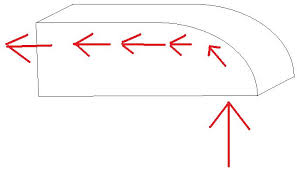
It is worth noting that its efficiency can be increased by installing it on a channel that is placed along a crooked line. In addition, a curved channel can also be used for this purpose. As a result, the thrust will be increased, and the efficiency of this device can be increased by twenty percent.
By itself, the job of this device is to redirect the flow of air masses. So, for example, if the air moves in a vertical direction from bottom to top, then the gases will be discharged through the upper hole, made in a round shape. Therefore, if the air masses go from top to bottom, then the lower hole is involved.
Deflector device
A wide variety of types of ventilation deflectors are currently on the market. They differ both in their design and in functionality. If we talk about the most common variety, then it is presented in the form of the Grigorovich model. It should be noted that the use of deflectors of this type is relevant not only for ventilation, but also for chimneys. Anyone can build a ventilation deflector with their own hands, if you use this design. As for other varieties, their drawings are much more complex and sophisticated.
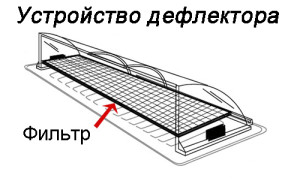
The deflector configuration consists of the following constituent elements: upper and lower cylinders, a cone and brackets in the amount of two pieces, which are used for fastening this device. A wide variety of materials can be used to make the deflector. The best option, in this case, there will be tin or galvanized. Specialized boiler steel is also perfect for this purpose.
Directly the production process of this design, you should start with a drawing and making accurate calculations of the details of the product. For the purpose of competent calculations of the technical characteristics and parameters of the ventilation deflector, one should take measurements of the diameter of the chimney or ventilation pipe in which the deflector will be placed. So, for example, if this value is twelve centimeters, then the use of ventilation deflectors fourteen and a half centimeters long will be relevant.
Construction process
To begin with, even before you start building the deflector device, you should check the availability of all the work necessary to carry out this operation. To this end, you may need the following:
- Scissors for cutting metal;
- Cardboard;
- Nuts and bolts, and rivets can also come in handy.
First, you should make blanks that are created by cutting them out of a cardboard sheet. Further actions are associated with the imposition of layouts on the metal, tracing with a scribe and cutting along the contour. For this purpose, we use special scissors specializing in metal cutting. In order for the parts to be fastened to each other, nuts and bolts or rivets, made, of course, of metal, are used. Brackets are made from a metal strip, which are welded to the diffuser together with the reverse cone.
Installation of the finished structure
The ventilation deflector is installed in the following way. First, place the bottom cylinder on top of the vent. Next, you need to fasten it with bolts and nuts. As for the lower cylinder, a diffuser is attached to it by means of a clamp. In the future, you should take the bracket and fix the reverse cone with it, as well as the cap.
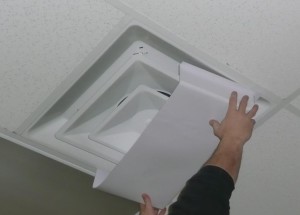
In cases where there is an excessively large chimney opening, it can be reduced with steel wire. For this purpose, it is loosened and wound around the hole. Among other things, it is recommended to install a ventilation deflector about 1.5-2 meters higher than the actual roof level is located. This is explained by the fact that in this way it becomes possible to improve traction.
Advantages and Disadvantages of Standard Design
If we talk about the strengths of using a deflector, then we can immediately note the excellent protective functions that help to avoid any atmospheric precipitation. In addition, it protects the deflector from all kinds of dirt. This is achieved through its umbrella-shaped design. Also, an advantage can be considered the effective implementation of their direct tasks, if the principle of operation of the ventilation deflector is correctly carried out.
As for the disadvantages, they include the fact that a situation of reflection of air masses from the cone may arise, which leads to a certain decrease in the efficiency of the ventilation deflector. In order to prevent such situations, devices can be used, which include two cones connected by bases. As for the additional cone located at the bottom, its main task is to remove the smoke outside.
Other varieties
There are also other types of ventilation deflectors. So, today, vane-type deflectors are rapidly gaining popularity. Let's talk about what a ventilation deflector of this type is. Such devices are designed for chimneys, they rotate following the movement of the wind.
Such deflectors consist of several component parts, including the bearing assembly and visors, as well as the housing itself. Its principle of operation is to create a rarefied zone, which is achieved due to the passage of wind currents between the canopies.
As a result, the thrust will be increased, and it will also be possible to achieve more efficient combustion of fuel in the furnace. Among other things, the air exchange within the chimney is also improved. So, the use of this device provides the possibility of additional ventilation. By using a wind vane, it becomes possible to prevent the possibility of sparks. In addition, the chimney is protected from the wind. This is achieved by rotating after him and the shutter of the hole.
However, this design also has weaknesses, including:
- Lack of stability in situations where there is a strong gusty wind;
- The need for regular maintenance of the bearing component, it should be lubricated;
- Soot can settle on the visor and condensation can form.
There is another, equally popular type of such devices - a rotary ventilation deflector. Its use is essential to bring natural ventilation down. Such a device can be considered effective also in cases where it is required to equip flue gas extraction when using gas boilers. His work is also based on rotation, but only in one direction.
The rotary deflector uses in its work the principle of converting wind energy, which is used in order to increase the traction performance. Its stable operation is guaranteed even in windy operation and with the heating turned off. If we talk about their biggest drawback, then here we can highlight the lack of the ability to work in cases where there is no wind, that is, in calm conditions.
Which device to choose is up to you. You can purchase a ready-made structure in the store, or cock it yourself. As you can see, a homemade device can perform its functions no worse than a store one.
The concept of "deflector" is probably known to many car owners. Deflectors for the hood and windows have become a popular part for car tuning. Fewer people know about another type of these devices used in construction - "ventilation" deflectors. What is a deflector in the understanding of builders?
The deflector for ventilation is an aerodynamic device fixed to the head of the chimney (channel). Installing a deflector increases the draft of the smoke and ventilation ducts and increases the overall efficiency of the flue gas or ventilation system.
The device works on the principle of the Bernoulli effect, a Swiss physicist who discovered the relationship between the flow rate of a liquid or gas and the pressure in a channel. In the narrowing of the channel, an increase in the flow rate of liquid or gas occurs, causing a decrease in pressure in this section of the pipeline (air duct).
Note:The ventilation deflector "catches" the wind passing through a narrow channel - a diffuser. This provokes a pressure drop at the top of the ventilation duct or chimney (where the deflector is installed). The vacuum under the diffuser is filled with air rising through the ventilation or smoke exhaust duct.
High-quality deflectors, the installation of which is carried out in accordance with all the rules, regulate the air flow in the diffuser and the direction of the discharge of gases supplied by the chimney. A well-designed and correctly installed ventilation deflector increases the efficiency of the exhaust duct by 20%. This allows you to level the lack of height of the chimney or insufficient section of the ventilation duct.
Varieties
The construction market offers many varieties of deflectors. They differ in material of manufacture, type of construction, purpose and appearance. It is worth noting that there are not only ventilation deflectors. The general public is most familiar with the deflectors used in aircraft and automobile manufacturing. Tuning lovers use car deflectors, the installation of which changes the air flow around the car body.

First of all, it is a hood deflector, deflectors (visors) for auto windows, called "visors". If various plastics are suitable for the production of automobile deflectors, devices for ventilation systems and flue ducts are made exclusively of metal. Their production uses:
- aluminum;
- stainless steel;
- galvanized;
- copper (rarely used due to the high price).
It is clear with the fields of application and materials. Now you can consider the design differences of the deflectors. On this basis, devices are divided into:
In addition to the basic types, there are many different designs that are sometimes difficult to classify. These are modern rotating deflectors with spiral blades rotating on a bearing, or elementary umbrella covers. Simple deflectors are very popular, the installation of which can significantly increase traction.
It is worth noting another method of classifying these devices - the division into static (stationary) and rotary (rotating) deflectors.
If speak about technical characteristicsthat distinguish such devices, there are not many of them:
- material of manufacture;
- sizes.
When choosing a deflector, you should pay attention to the design of the product. After the desired design type has been selected, you can start selecting the optimal size.
Calculation of performance and selection of the optimal design of ventilation deflectors is a topic for a separate article. In this text, we will consider devices for fireplace and stove chimneys.
Rotary deflectors
Rotating devices are used in ventilation systems and in chimneys. They do not require a motor - they rotate by the wind. The rotating turbine creates a vacuum in the channel, which draws out excess heat and moisture, harmful gases and dust, protects indoor spaces from condensation.
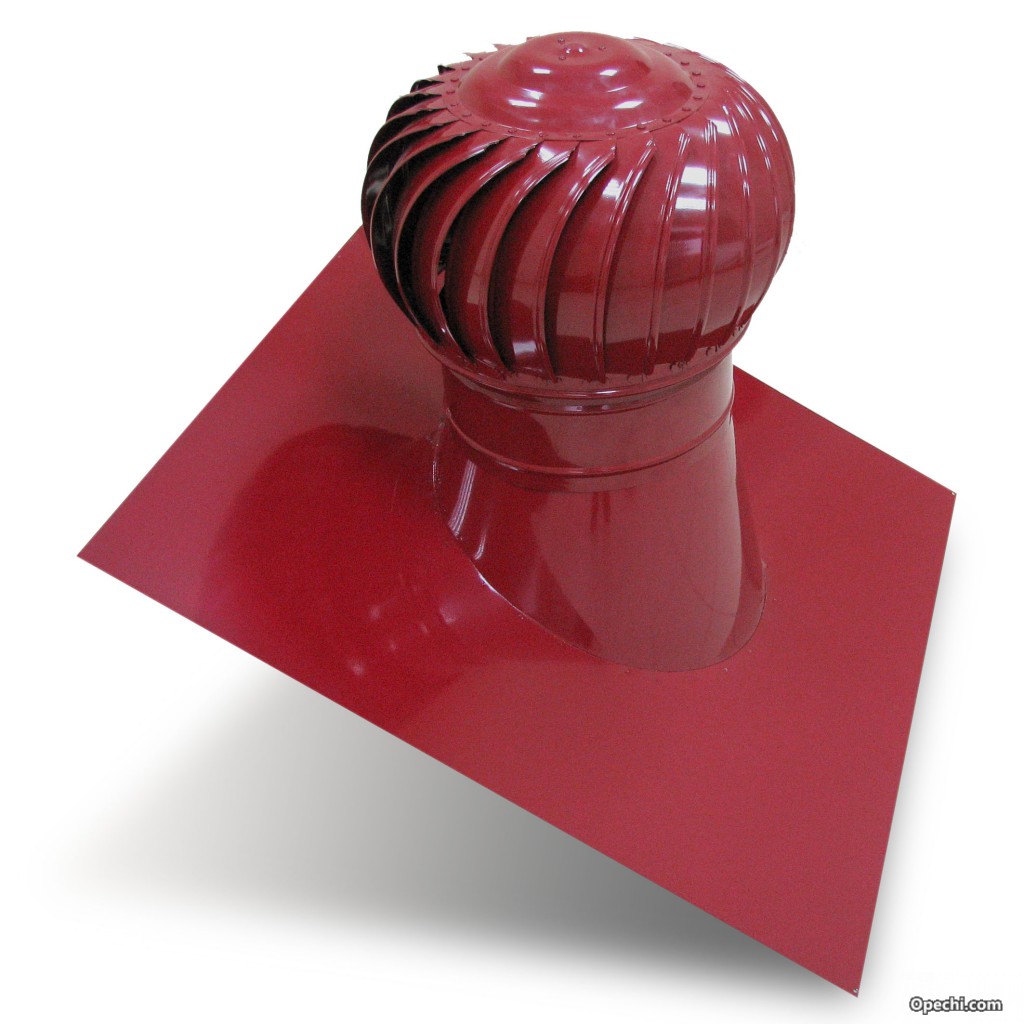
Regardless of the direction of the wind, the head of the rotary deflector rotates in the same direction, increasing the draft in the flue and ventilation duct due to the vacuum. The rotating head prevents back draft in the channel.
It is especially convenient that the installation of rotary type deflectors does not require power supply. They use wind energy.
Deflector device
As mentioned above, the ventilation deflector of Grigorovich's design is the simplest device. Let's consider the design of products using his example.
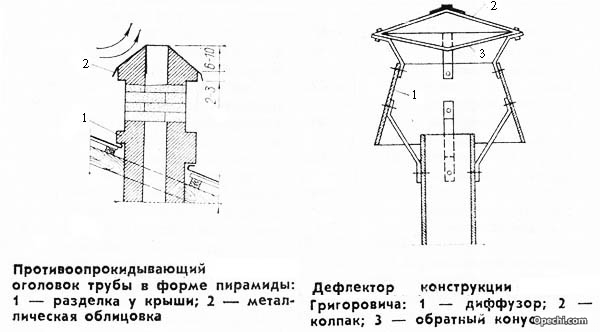
If you are interested in the independent manufacture and installation of deflectors, it is better to take this particular design as a basis. Better to start simple.
The deflector design consists of the following elements:
- upper cylinder;
- lower cylinder;
- branch pipe (enters the lower cylinder);
- cone (cap);
- mounting brackets.
The top cylinder is optional and may be missing. In this case, the deflector includes:
- lower cylinder put on ( ventilation pipe);
- air diffuser;
- cones (reverse and straight).
In this embodiment of the deflector, the cone is at the same time a cap that protects the pipe from precipitation.
Deflector do it yourself
The simplest deflector - diagramIt is quite simple to make a ventilation deflector yourself. You will need the following tools and materials, which are easy to buy in any "hozmag":
- metal (galvanized, stainless steel);
- scissors for metal;
- rivets with rivets or just bolts with nuts;
- ruler and marker (pencil);
- thick cardboard;
- scissors or utility knife.
It is necessary to start with measurements and calculations - measure the height and diameter of the pipe, establish the planned dimensions of the manufactured deflector. If this is your first time doing this kind of work, you should try making a cardboard layout first. This material allows you to quickly and easily make a complete copy of the metal deflector, and the cost of error is small.
Work should start with the manufacture of the lower cylinder. Its diameter is set according to the pipe diameter.
Note:It is important not to be mistaken: the inner diameter of the cylinder must match the outer diameter of the pipe.
The next cone is made, for which a round part is cut out of the metal. A slot is made along the radius of the part (from edge to center) and one edge is wound after the other, forming a cone.
The rest of the deflector parts are made in the same way.
It is better to connect the parts to each other using rivets or bolted connections according to the diagram. As a result, we have deflectors, the installation of which on the pipe does not take much effort.

Manufacturing of rotary deflectors is much more complicated. If you have little experience in making such products, a rotating deflector is easier to buy. the main problem in that rotating parts require very precise calculation and manufacturing with small tolerances. Therefore, if you decide to make a ventilation deflector with your own hands, it is better to stay on a static structure.
Any motorist knows how inconvenient it can be to ventilate in crosswinds, rain or other unpleasant weather conditions. Windscreens, or as they are also called, side window deflectors are an excellent solution to the issue. Let's see what it is and how for a car.
How the deflector works
Let's start with the fact that in translation from English "deflector" is a cutter. That is, window deflectors on a car are designed to cut off air flows that carry dust and moisture microparticles into the car interior. Their main task is to ensure a certain aerodynamics of the body, in which foreign particles of pollution do not enter the interior of the car.
The deflector is located in the upper part of the side opening and is a kind of visor. Due to the fact that it has a front reflective wall of a special shape, the visor not only prevents the penetration of dirt from its upper side, but also from its front part, from where dust and dirt usually enter the car interior.
Another effect that the driver and passengers often pay attention to is the presence of a deflector ensures uniform ventilation of the passenger compartment and prevents strong air currents. Of course it's his side effect and not basic, but often it is fundamental when choosing a particular model of a deflector.

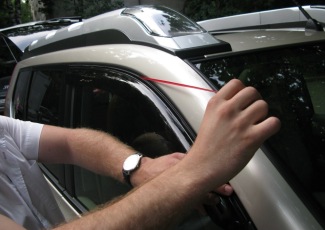


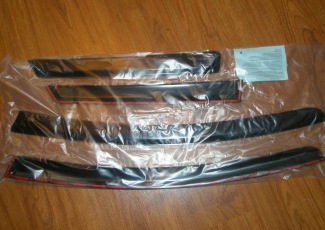
Glass deflectors - about the installation features
As a rule, the visors are mounted on the top of the drop-down glass frame. There are two types of fastening - glue-based and conventional, by mechanical connection. A visor sticker is a thankless task, since there is a high probability of damage to the paintwork.
If the deflectors on the car windows do not match the geometry of the window opening (which is often found in cheap non-original manufacturers), then it is fraught with some dangers. For example, in case of strong wind or driving at high speed, the visor can tear off with part of the paintwork, due to which the body will be damaged and you will have to fork out for additional work.
Therefore, the most convenient option from the point of view of installation is insert window deflectors. For their installation, you do not need to use adhesive joints that can harm the paintwork; such deflectors are attached exclusively using a mechanical connection. The only exception are cars in which the side windows in their upper part adjoin directly to the body - it is simply impossible there. A striking example of this is the Subaru Forester of the late 2000s.
How to choose the right side window deflectors?
The first thing to worry about when choosing deflectors is geometry. If the bending angle does not correspond to the corresponding bending angle of the body, you can forget about durability. Such a visor is easy to install, but the plastic will constantly be in tension and the slightest mechanical impact can damage it. Most often, this is the sin of universal visors or those that are selected manually. Fitting is never good.
Another factor in the selection of the deflector is the shape of its working part. Even if the seat follows the curvature of the body, the deflector's deflection angle can cause additional resistance during driving, especially at high speeds.
As a result, there is a loose fit of the seals, their detachment from the body, damage to the paintwork, or breakage of the deflector itself. Therefore, it is important to pay attention the right choice such an accessory.
In short, all the characteristics to consider when choosing a deflector can be arranged as follows, in order of decreasing importance:
- Compliance with original geometry.
- Mount type.
- Workmanship.
- Wing geometry.
- The quality of the material.
The answer to the question - what is a car deflector - is simple - it is an optional accessory. But do not forget that the presence of such an accessory sets itself the task of providing a comfortable ride, and not making your car unique or allowing you to stand out from the crowd. Therefore, it is better to purchase a visor in a trusted service, where they can install it and at least somehow guarantee the quality of installation, than to choose a deflector photo of which you like more than others in an online store, but in operation it will turn out to be impractical and unreliable.
A modern country house with its sealed windows and doors without a high-quality ventilation system risks turning into a steam room at any time. Effective ventilation is designed to solve this problem. The system consists of a variety of devices. In this article we will figure out what a deflector is, why you need it, and how to install it correctly.
The principle of operation of the deflector and its structure
The deflector is a “hood” device mounted on top of the chimney to protect the ventilation duct and provide constant draft for the entire ventilation system.
What is a photo deflector
Today you can find deflectors of different designs. The main parts of the device:
A diffuser is a part of a pipe that resembles a truncated cone in construction. It is this part of the device that increases the air pressure at the head;
The cap protects the pipe from small debris and precipitation.
Cylindrical outer casing, cuts the air flow, creating a low pressure area.
The material of manufacture can be copper or tin; it is allowed to manufacture a deflector from boiler steel.
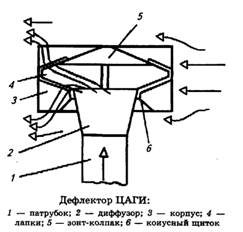
Types of devices and their purpose
A deflector is a device that can have a different design and differ in purpose:
With flat nozzle... Such deflectors are considered the simplest, they are easy to make yourself.
With opening nozzle... We recommend this type of deflector for chimneys that need frequent cleaning.
With pliers... Such a deflector on the chimney provides more reliable protection ventilation system from snow, wind and rain, we recommend for installation in areas with frequent snowfalls and strong winds.
Ball-shaped nozzle... Deflectors have an interesting appearance, will fit into the design of any modern home, cottage or villa.
Deflector do it yourself
Before you start making a deflector on a pipe with your own hands, you need to know that the device has its own parameters: height 1.7 from the diameter of the ventilation duct, width 1.9 from the same inner diameter.
Important: it is better to choose copper as a material of manufacture, this material expensive, but the strongest. The copper deflector for the chimney is resistant to any atmospheric conditions and will last more than 30 years without the need for repair.
The procedure for manufacturing the device:
Creation on paper of a drawing of the main parts - a cap, a body, a diffuser.
Drawings must be transferred to the metal and cut out the necessary parts with metal scissors.
The resulting parts are connected with rivets or bolts. Pieces can also be welded.
Before installing the deflector on the pipe, it must be assembled “on the ground”. At a height, it remains only to fix the parts of the deflector to the chimney.
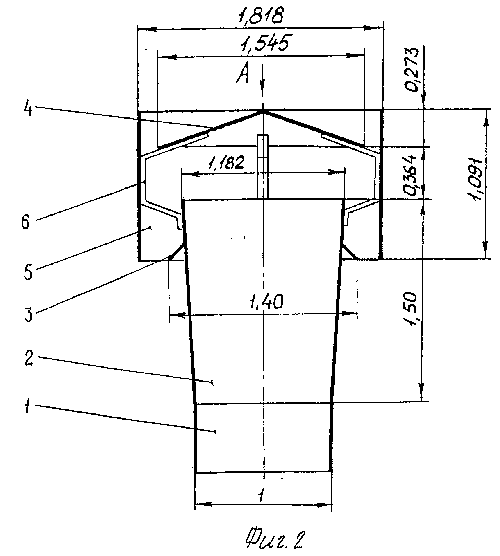
Diy chimney deflector drawing
Installation
Installation of a deflector on a ventilation pipe is not difficult, but it requires adherence to certain rules. The first is to install the branch pipe into the pipe, it is fastened with rivets or bolts. Further, the lower brackets are fixed to the branch pipe, and the diffuser funnel is installed on them. The diffuser is secured with clamps.
The nozzle is mounted to the top of the diffuser with rivets.
Video
Tipping is a common problem with every hood. It occurs when air is sucked into a room, rather than pulled out of it. Thus, all chimneys can be converted into additional sources of cooled air flow into the room. To solve this problem, ventilation deflectors are used. Such devices are mounted at the end of the chimney.
Deflectors have been invented for a long time, but they were used only for chimneys. These devices solve a number of basic tasks: they create an obstacle for precipitation, the exhaust hole is protected from blowing out, dirt and debris do not get into the pipes. Thus, each deflector is able not only to secure the process of air mass circulation in the room, but also to increase the service life of the mine.
The principle of operation of the deflector
Ventilation deflectors are installed on the pipes so that the wind does not blow into the exhaust shaft. For clarity, you can imagine the simplest office split system. Surely everyone has seen that condensing devices are equipped with special screens for protection. This is somewhat similar to the principle of operation of the deflector.
A large number of types of these products are being developed, but they all operate on the same principle. Air is directed into the diffuser - the cap above the deflector, and hits the side of the product. The stream flows around the entire structure without passing into it. In this case, the processed air is removed from the pipe without obstruction.
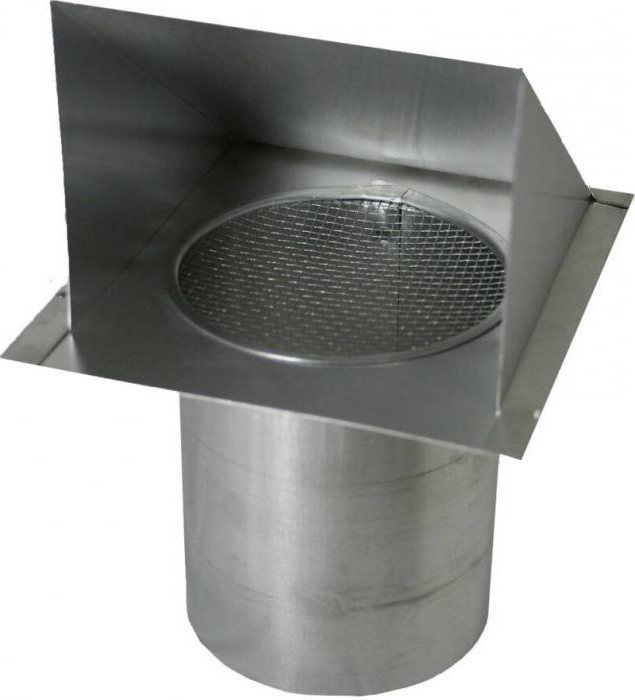
Materials
The product has been used for a long time and has been modernized many times until today. New models are developed from time to time. In the manufacture of exhaust ventilation deflectors, plastic or galvanized steel is used. Metal products can last much longer. It is better to give preference to these particular deflectors, and not plastic ones.
As mentioned earlier, these products are used not only for the protection of hoods, but also for chimneys. Every home owner has the opportunity to significantly increase traction and protect his fireplace or stove from overturning air currents by installing ventilation deflectors. In such cases, plain galvanized steel is not suitable. A special boiler metal must be used. This is a fairly durable and expensive material that can withstand much more high temperatures and not burn out at the same time. If the flow cools down before leaving the chimney, you can safely install a ventilation deflector made of galvanized metal. Therefore, it is recommended to make a preliminary calculation of the possible heating of the smoke coming out through the chimney.
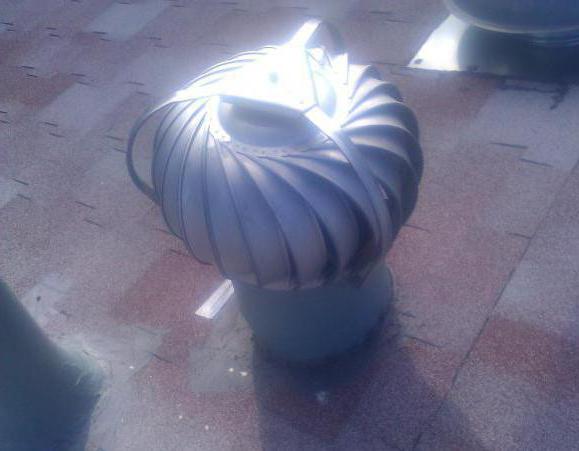
What are the deflectors of ventilation systems?
Not only external, but also internal deflectors are often used. They are designed to disperse fresh currents and prevent drafts. Thus, air masses are distributed more evenly throughout the room in which the split system or air inlet is installed. The exhaust air is forced out faster, and the visitors of the room are not blown out. Before choosing a deflector for a ventilation system, it is necessary to consider the available range of models that differ in type of design, which include TsAGI devices, the Shenard model, Volper, the Astato open deflector, Grigorovich's sample, a spherical rotating device.
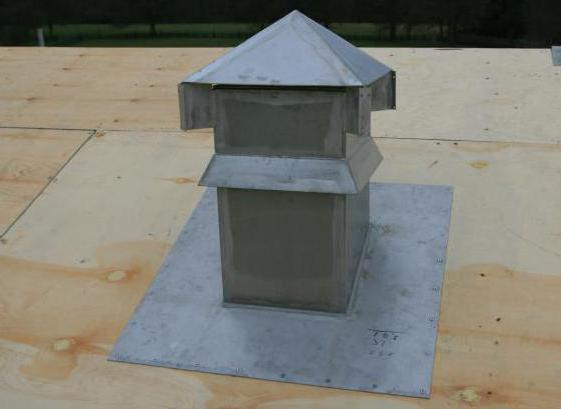
Deflector do it yourself
You can make quality products yourself that will work no worse than the factory series. The ventilation deflector is very simple to create. You just need to do correct calculations, having previously measured the exhaust hole. Suitable proportions can easily be found in the relevant literature. After completing all the calculations, it's time to start assembling the ventilation deflector yourself.
How are ventilation deflectors created?
What's the point of paying money for a finished device if you can buy everything necessary materials and assemble the deflector yourself. From the tools you will need a tape measure, a welding machine, galvanized steel, metal scissors, a grinder and a drill, nuts, bolts, clamps, a set of keys. With your own hands, you can recreate almost all existing deflector designs. The simplest option for self-production would be the Grigorovich model without complex mechanisms and connections.
First you need to make a drawing, then cut out the cardboard layout in full size, transfer the dimensions to steel and cut out the blanks of the parts. To assemble the model, welding machines and other additional connecting elements are most often used. The deflector bracket can be cut from strips of metal. The cap is fixed with cut-out fragments, and a cone is installed on top. The creation of such a device makes it possible to increase the efficiency of the ventilation system by 15-20%, as well as to protect against debris and moisture from entering the pipe.
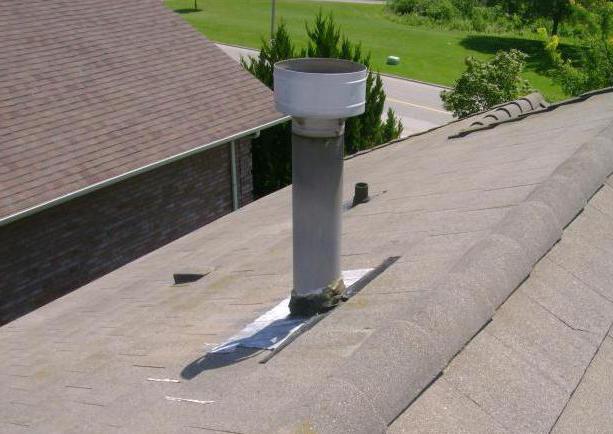
Conclusion
Based on the information received, it is possible to understand the types of existing ventilation systems. They are designed to protect pipes from air and dirt from the street. Thanks to these devices, it is easier for streams to leave the room. Deflectors have been used for a long time, and during this time their design has changed several times. A lot is available on the domestic market finished products... One of the most common is the ventilation deflector series 5 904 51. The best option for self-assembly would be the Grigorovich installation.



